

There are times when imaging the Moon at night is difficult or inconvenient. This is particularly true in the summer when nights are short and the Moon at night is very low in the sky. Often the solution is to image the Moon during the day. I don't have a permanent observatory and I have to assemble my telescope each time I want to use it. Therefore I must align it too, but I can't see the stars. (It is possible to see the brighter stars in the daytime with a telescope but, in my case, this does not include the all-important Pole Star.) At start-up the LX200 assumes that it is pointing due south and at zero declination. So I set it up as best I can with a compass and a spirit level and point it south. I then use the GOTO to send it to the Moon and, assuming I can see the Moon (which I usually can), I adjust the wedge and tripod to get the Moon centred in the finder. This only works well if the Moon is somewhere close to south, but it is best there anyway. If it is east or west the technique doesn't work at all and I use the telescope's adjustments to find the Moon and sync on it; drift is usually not bad enough to prevent imaging. Finally I install an infra-red pass filter (home made from two layers of fogged colour film). The scattering of light from the sky is what is termed Rayleigh Scattering and its intensity is inversely proportional to the fourth power of the wavelength (which is why the sky appears blue), so the longer the wavelength used the less the interference from the sky; hence the use of the infra-red. I often image the Moon in infra-red to reduce sky glow even at night and it produces excellent images.
On this page I have a small selection of pictures taken on 18th July 2006 at around 0800 GMT (i.e. local solar time). At that time the Moon was at azimuth 219° and altitude 47°, whilst the Sun was at azimuth 98° and altitude 33½°. This was some 4 hours after sunrise, and the Moon was 22.7 days old.
I've not included any mouseovers but the images themselves are links to other pages where the same features are shown and mouseovers with labels and scale markers are available, along with some descriptive text. I have arranged that these open in new windows so that you can switch back and forth if you wish, but close the new windows if you do not want them all open at the same time.
Finally, contrary to my usual practice, I have inverted all the pictures from the southern hemisphere, so that south is at the top. This gives pictures which look more like you might see if you were flying over the surface but it does mean that the standard pictures to which they link are the other way up. Confusing? -- Sorry!.
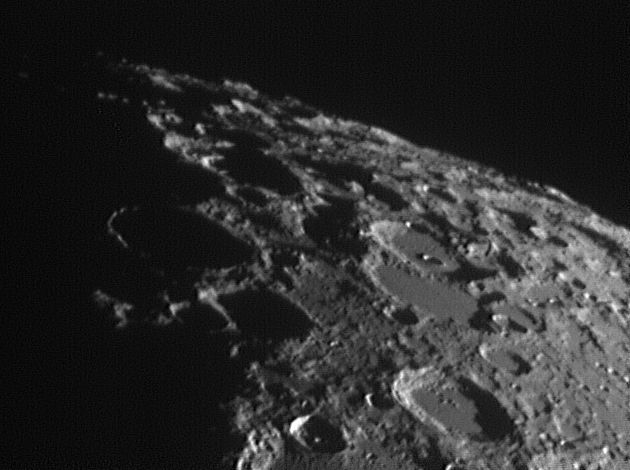
This is the far south seen with south at the top. The two intersecting craters are Kloproth (the older and more northerly) and Casatus (evidently younger as it overlies Klaproth) with Casatus C within it. The crater just north (below) this pair is Blancanus, which lies close to Clavius which is just beyond the bottom of the picture.
Date and Time: 18th July 2006 08:21 UT
Camera: ToUcam 740K
Telescope: LX200 at prime focus
Capture: K3CCDTools. Low gamma, 1/33", 28% gain, 508 frames
Processing: Registax. 128 frames stacked. Wavelets 1 = 10, 2 = 5, gamma 0.7, histogram 0-200
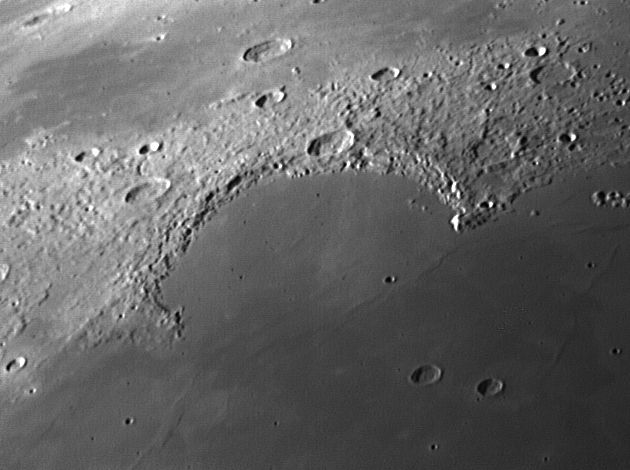
This is the Sinus Iridum, a bay on the northern shores of the Mare Imbrium. It represents a large crater formed some time after the creation of the Imbrium Basin but before the basin was flooded with lava. There was more than one flooding event, and the edges of the later ones can be seen as ridges across the lava plains. One can be seen here running west from the eastern (right-hand) end of the Sinus Iridum. They are more clearly seen on the second image down on my main Sinus Iridum page (click on the picture to go there) where the different shading of the lavas in the infra-red can also be seen. (Linked from that page is an exaggerated-colour image which also shows the difference in colour of these lavas.)
Date and Time: 18th July 2006 08:21 UT
Camera: ToUcam 740K
Telescope: LX200 at prime focus
Capture: K3CCDTools. Low gamma, 1/33", 28% gain, 508 frames
Processing: Registax. 128 frames stacked. Wavelets 1 = 10, 2 = 5, gamma 0.7, histogram 0-200
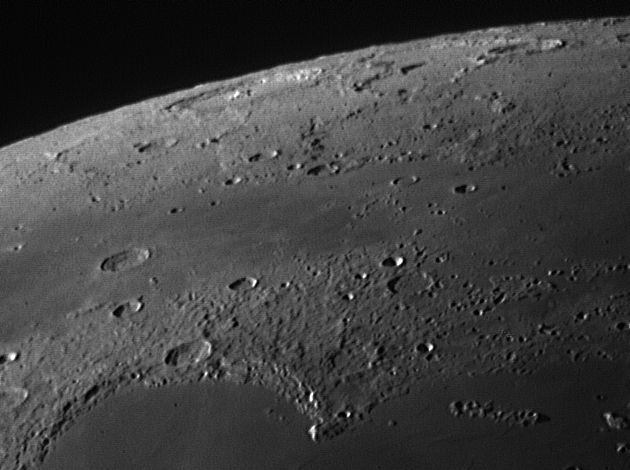
The clearly-defined crater at the top of this picture is Pythagoras. I am very pleased with the clarity of this picture of it. Clicking on the image will take you to a slightly closer view with a mouseover that identifies most of the craters in this picture. The broad stretch of dark material across the middle of the picture is part of the Mare Frigoris with the crater Harpalus dividing it. At the bottom is the Sinus Iridum, a bay off the northern edge of Mare Imbrium. A wider-angle view of this whole area can be seen here.
Date and Time: 18th July 2006 08:23 UT
Camera: ToUcam 740K
Telescope: LX200 at prime focus
Capture: K3CCDTools. Low gamma, 1/33", 22% gain, 481 frames
Processing: Registax. 44 frames stacked. Wavelets 1 = 10, 2 = 5, gamma 0.7
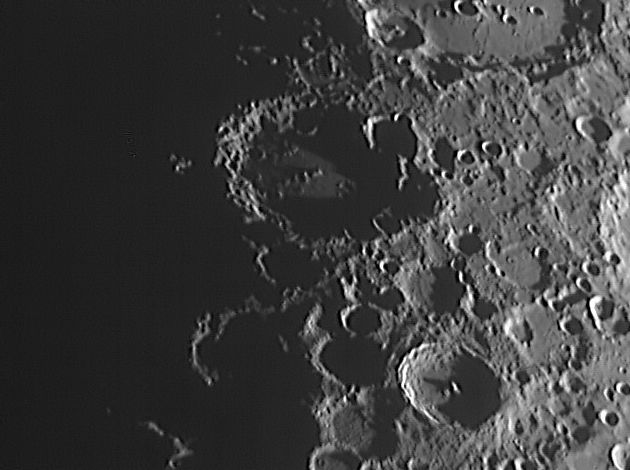
This is Maginus, which lies north-east of Clavius (at the top of this picture) and south of Tycho which is at the bottom of this picture. I have no other picture which centres on Maginus; clicking on the image will take you to a wide-angle picture showing the whole area.
This picture has south at the top.
Date and Time: 18th July 2006 08:10 UT
Camera: ToUcam 740K
Telescope: LX200 at prime focus
Capture: K3CCDTools. Low gamma, 1/33", 28% gain, 299 frames
Processing: Registax. 82 frames stacked. Wavelets 1 = 10, 2 = 5, gamma 1.4, histogram 0-200, brightness -24
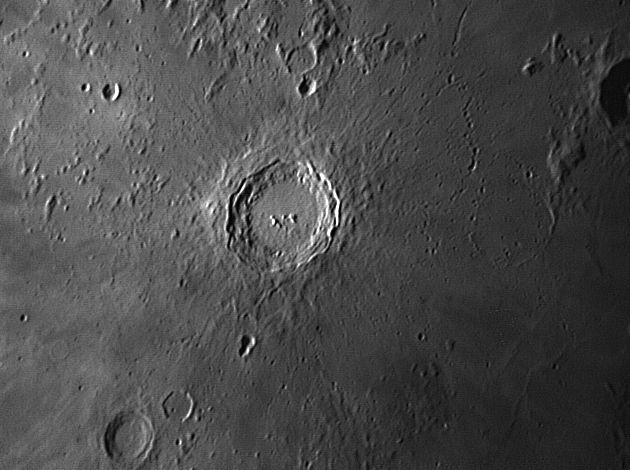
This is Copernicus, a recent and isolated crater on the eastern boarders of Oceanus Procellarum.
Date and Time: 18th July 2006 08:14 UT
Camera: ToUcam 740K
Telescope: LX200 at prime focus
Capture: K3CCDTools. Low gamma, 1/33", 28% gain, 400 frames
Processing: Registax. 54 frames stacked. Wavelets 1 = 10, 2 = 5, gamma 0.7, histogram 0-200, brightness -10
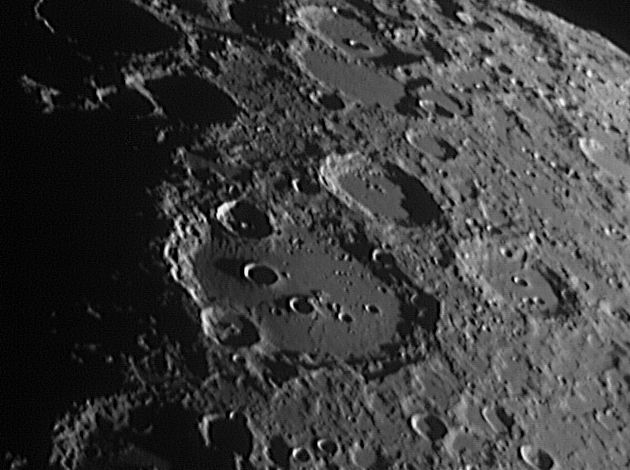
This is Clavius in the foreground with Blancanus above to the right, and Klaproth and Casatus at the top of the picture.
This picture has south at the top.
Date and Time: 18th July 2006 08:06 UT
Camera: ToUcam 740K
Telescope: LX200 at prime focus
Capture: K3CCDTools. Low gamma, 1/33", 28% gain, 461 frames
Processing: Registax. 93 frames stacked. Wavelets 1 = 10, 2 = 5, gamma 1.4, histogram 30-140, brightness -10
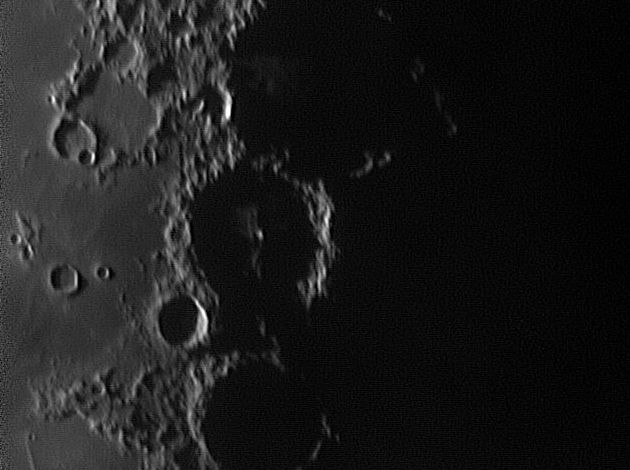
This is Alphonsus at sunset on this part of the Moon and so not the best time to image the crater. Click on the image to see a picture taken a day earlier which shows the crater much more clearly. What a difference one day makes!
Date and Time: 18th July 2006 07:58 UT
Camera: ToUcam 740K
Telescope: LX200 at prime focus
Capture: K3CCDTools. Low gamma, 1/33", 41% gain, 414 frames
Processing: Registax. 119 frames stacked. Wavelets 1 = 10, 2 = 5, gamma 2.0, brightness -110, histogram 0-140
Home Back to the Moon